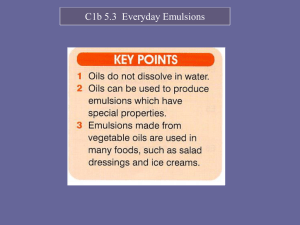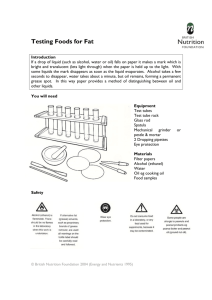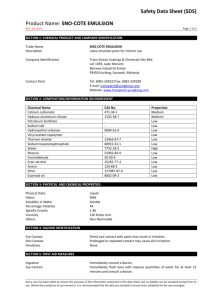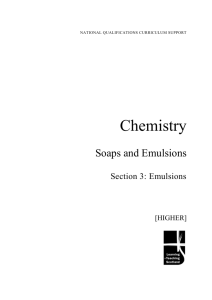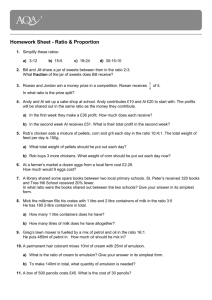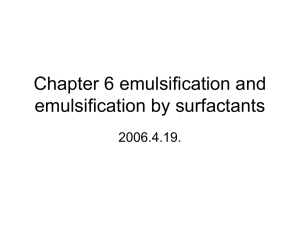Emulsion 2014 questions
advertisement
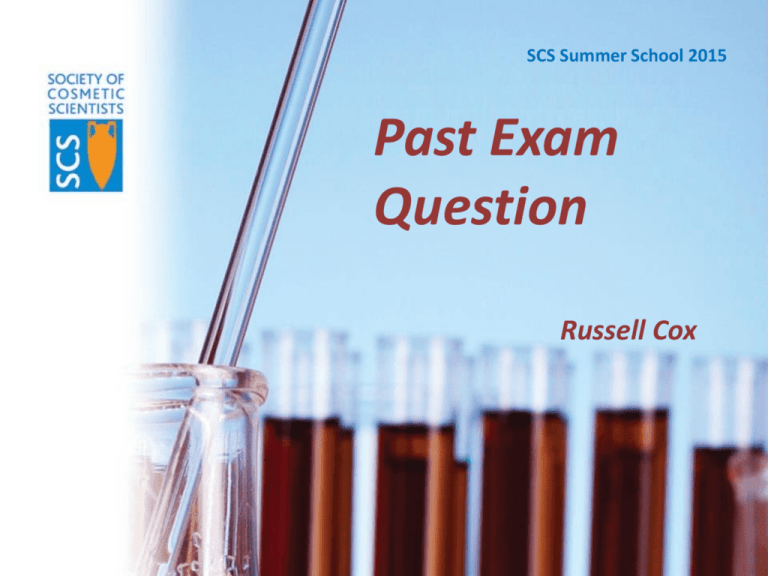
SCS Summer School 2015 Past Exam Question Russell Cox 2014 Emulsion Exam Question • • • Read the question fully before starting to write your answers Look at the allocation of marks for particular sections of the question Don’t panic! a; • Define what an emulsion is, and describe the two main types that are found in cosmetic formulations (3) a; • Define what is an emulsion, and describe the two main types that are found in cosmetic formulations (3) • An emulsion is a dispersion of one phase in another non-miscible phase. • Cosmetic formulations tend to be made from oil and water, the two most common types are oil in water (O/W) and water in oil (W/O). b; • The type of emulsion cannot simply be determined by considering the relative percentages of the water and oil phases. How does one theoretically describe the emulsion formed? (1) b; • The type of emulsion cannot simply be determined by considering the relative percentages of the water and oil phases. How does one theoretically describe the emulsion formed? (1) • Bancroft rule states “The phase in which an emulsifier is more soluble constitutes the continuous phase”, therefore an O/W emulsion requires an emulsifier that is preferentially soluble in the water phase c; • Are emulsions stable? (1) • Thermodynamically emulsions are metastable –in the emulsified state, they are stable for a period of time however, the two immiscible phases will eventually separate out. The exception to the rule is microemulsions d; • How can one visually tell if an emulsion is stable or not? (6) • Creaming, Where the less dense phase migrates to form a layer at the top of the emulsion • Sedimenting, occurs when the denser dispersed phase migrates to form a layer at the bottom of the emulsion d; • Flocculation, where the dispersed droplets cluster together, but do not lose their droplet identity. Flocculation gives an appearance of a fluffy cloud like suspension in the emulsion, which can be redispersed by mixing the emulsion again. • Coalescence, similar to flocculation, except the droplets merge with each other to form a larger droplet. Coalescence is a non-reversible process, and can only be prevented by re-formulating the emulsion. d; • Phase inversion. Where the phase of the emulsion inverts from one type to another, for example an O/W inverts to a W/O emulsion. This can occur when the emulsifier becomes more soluble in the dispersed phase • Ostwald ripening. In solid solutions or liquid sols, the small crystals or sol particles dissolve and redeposit themselves as larger particles, as thermodynamically larger particulates or droplets are more stable. In the case of emulsions, molecules diffuse from small droplets to form large ones within the continuous phase. e; • ∆G=(γA)-(T∆S) • Define the terms in the equation and describe how they relate to the stability of an emulsion. (5) e; • ∆G=(γA)-(T∆S) • Define the terms in the equation and describe how they relate to the stability of an emulsion. (5) • ∆G = gibbs free energy, an indicator of the thermodynamic stability of an emulsion. If the value of ΔG is positive then spontaneous emulsification is unlikely, if ΔG is negative then spontaneous emulsification will occur. Additionally the closer the value of ΔG is to zero the easier the emulsification process will be. e; • γ = interfacial tension. Reducing the surface energy and thus reduce the interfacial tension between the dispersed droplet and the continuous phase. Therefore using an emulsifier will reduce the γA value and lower the value of ΔG. • A = interfacial area. Reducing the surface area reduces the contribution of the γA value, thus reducing the value of ΔG e; • T = temperature. Increasing the temperature will increase the magnitude of the TΔS value, and thus reduce the overall value of the Gibbs free energy for the system. • ΔS = entropy of mixing. Increasing the entropy (or level of disorder within the system) will also increase the TΔS value, and thus reduce the magnitude of ΔG. f; • What is an emulsifier and how does their use influence the stability of an emulsion? (2) f; • What is an emulsifier and how does their use influence the stability of an emulsion? (2) • An emulsifier can be visualised as containing a hydrophilic (water loving) head, and a hydrophobic (oil loving) tail. Due to its structure the emulsifier will sit at the interface between the dispersed droplet and the continuous phase. The inclusion of an emulsifier into an emulsion system will have the effect of reducing the surface energy of the dispersed droplet g; • Explain what is HLB? Discus the advantages and disadvantages of the HLB theory (4) g; • Explain what is HLB? Discus the advantages and disadvantages of the HLB theory (4) • HLB is the hydrophilic lipophilic balance, proposed by Griffin to account for the behaviour of emulsifiers • The theory assigns the emulsifier a value to represent its affinity towards either the oil or water phase. The number is in the scale of 1-20 where the lower the number the more oil miscible the emulsifier and the higher the number the more water miscible g; • The obvious advantages of the HLB theory is emulsifiers can be categorised by their potential behaviour and emulsifier blends can be tailored to specific oil systems • There are a few disadvantages; it does not consider the ratio of oil phase to water phase, no indication as to the level of emulsifier required, it doesn’t work well for emulsifying waxes or account properly for the use of fatty alcohols, no consideration of the effect of temperature or electrolytes on the HLB of ethoxylates h; • How may HLB be used to select emulsifiers for a particular emulsion system, and how does it relate to defining the type of emulsion formed? (3) • The HLB requirement of a blended oil phase can be either calculated or determined experimentally. • Once the HLB requirement is known, the percentage of emulsifiers required to achieve the target HLB can be calculated. h; • To determine the type of emulsion O/W or W/O, one would review the relative percentages of each emulsifier and the respective individual HLB values • The emulsifier present in the greater proportion would be, according to Bancrofts rule, considered for its solubility in its preferred phase • The higher the HLB value (>10) for the larger quantity emulsifier then the more likely a O/W emulsion will be formed –and vice versa, if its HLB value was lower (<10) then the emulsion will tend to be W/O

